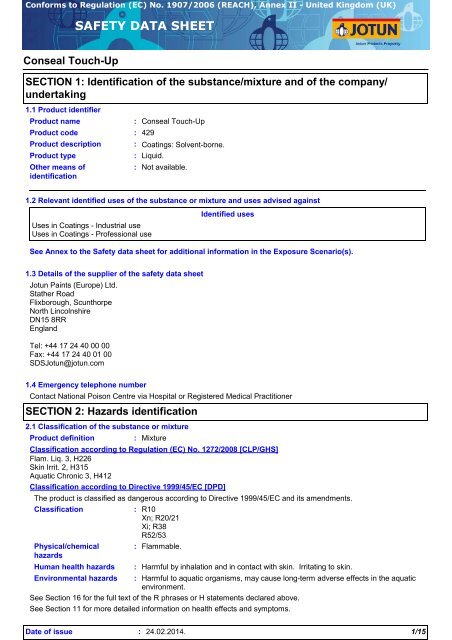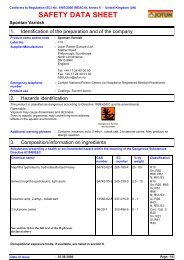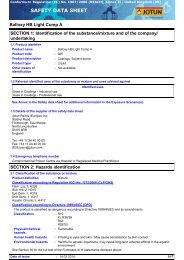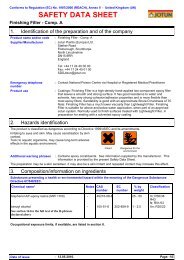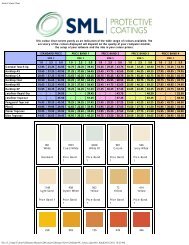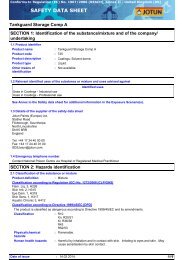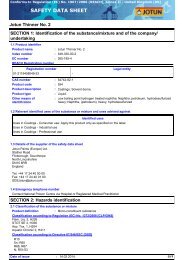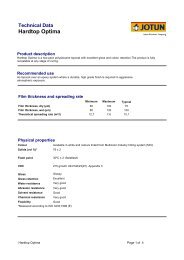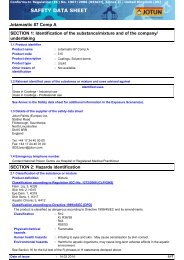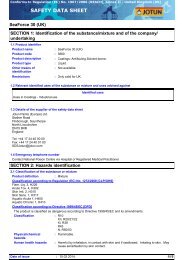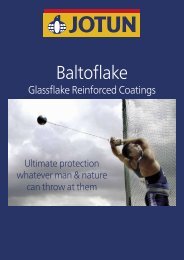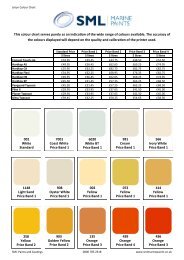Safety data sheet for Conseal Touch-Up - SML Marine Paints
Safety data sheet for Conseal Touch-Up - SML Marine Paints
Safety data sheet for Conseal Touch-Up - SML Marine Paints
Create successful ePaper yourself
Turn your PDF publications into a flip-book with our unique Google optimized e-Paper software.
Con<strong>for</strong>ms to Regulation (EC) No. 1907/2006 (REACH), Annex II - United Kingdom (UK)SAFETY DATA SHEET<strong>Conseal</strong> <strong>Touch</strong>-<strong>Up</strong>SECTION 1: Identification of the substance/mixture and of the company/undertaking1.1 Product identifierProduct name :Product code :Product description :Product type :Other means ofidentification:<strong>Conseal</strong> <strong>Touch</strong>-<strong>Up</strong>429Coatings: Solvent-borne.Liquid.Not available.1.2 Relevant identified uses of the substance or mixture and uses advised againstUses in Coatings - Industrial useUses in Coatings - Professional useIndustrial applications, Professional applications, Used by spraying.Identified usesSee Annex to the <strong>Safety</strong> <strong>data</strong> <strong>sheet</strong> <strong>for</strong> additional in<strong>for</strong>mation in the Exposure Scenario(s).1.3 Details of the supplier of the safety <strong>data</strong> <strong>sheet</strong>Jotun <strong>Paints</strong> (Europe) Ltd.Stather RoadFlixborough, ScunthorpeNorth LincolnshireDN15 8RREnglandTel: +44 17 24 40 00 00Fax: +44 17 24 40 01 00SDSJotun@jotun.com1.4 Emergency telephone numberContact National Poison Centre via Hospital or Registered Medical PractitionerSECTION 2: Hazards identification2.1 Classification of the substance or mixtureProduct definitionClassification according to Regulation (EC) No. 1272/2008 [CLP/GHS]Flam. Liq. 3, H226Skin Irrit. 2, H315Aquatic Chronic 3, H412Classification according to Directive 1999/45/EC [DPD]ClassificationPhysical/chemicalhazardsHuman health hazards: MixtureThe product is classified as dangerous according to Directive 1999/45/EC and its amendments.:R10Xn; R20/21Xi; R38R52/53: Flammable.:Harmful by inhalation and in contact with skin. Irritating to skin.Environmental hazards : Harmful to aquatic organisms, may cause long-term adverse effects in the aquaticenvironment.See Section 16 <strong>for</strong> the full text of the R phrases or H statements declared above.See Section 11 <strong>for</strong> more detailed in<strong>for</strong>mation on health effects and symptoms.Date of issue : 24.02.2014.1/15
Con<strong>for</strong>ms to Regulation (EC) No. 1907/2006 (REACH), Annex II - United Kingdom (UK)<strong>Conseal</strong> <strong>Touch</strong>-<strong>Up</strong>SECTION 3: Composition/in<strong>for</strong>mation on ingredientsThere are no additional ingredients present which, within the current knowledge of the supplier and in theconcentrations applicable, are classified as hazardous to health or the environment, are PBTs or vPvBs or have beenassigned a workplace exposure limit and hence require reporting in this section.Occupational exposure limits, if available, are listed in Section 8.SECTION 4: First aid measures4.1 Description of first aid measuresGeneralInhalationSkin contactEye contactIngestionProtection of first-aiders::::In all cases of doubt, or when symptoms persist, seek medical attention. Never giveanything by mouth to an unconscious person. If unconscious, place in recoveryposition and seek medical advice.Remove to fresh air. Keep person warm and at rest. If not breathing, if breathing isirregular or if respiratory arrest occurs, provide artificial respiration or oxygen bytrained personnel.Remove contaminated clothing and shoes. Wash skin thoroughly with soap andwater or use recognised skin cleanser. Do NOT use solvents or thinners.Check <strong>for</strong> and remove any contact lenses. Immediately flush eyes with runningwater <strong>for</strong> at least 15 minutes, keeping eyelids open. Seek immediate medicalattention.: If swallowed, seek medical advice immediately and show the container or label.Keep person warm and at rest. Do NOT induce vomiting.: No action shall be taken involving any personal risk or without suitable training. Itmay be dangerous to the person providing aid to give mouth-to-mouth resuscitation.4.2 Most important symptoms and effects, both acute and delayedPotential acute health effectsEye contactInhalationSkin contactIngestionOver-exposure signs/symptomsEye contactInhalationSkin contactIngestion:: No known significant effects or critical hazards.: Causes skin irritation.:Causes serious eye irritation.Irritating to mouth, throat and stomach.: Adverse symptoms may include the following:pain or irritationwateringredness: No specific <strong>data</strong>.: Adverse symptoms may include the following:irritationredness: No specific <strong>data</strong>.4.3 Indication of any immediate medical attention and special treatment neededNotes to physicianSpecific treatments::Treat symptomatically. Contact poison treatment specialist immediately if largequantities have been ingested or inhaled.No specific treatment.SECTION 5: Firefighting measures5.1 Extinguishing mediaSuitable extinguishingmediaUnsuitable extinguishingmedia::Recommended: alcohol-resistant foam, CO₂, powders, water spray.Do not use water jet.5.2 Special hazards arising from the substance or mixtureDate of issue : 24.02.2014.3/15
Con<strong>for</strong>ms to Regulation (EC) No. 1907/2006 (REACH), Annex II - United Kingdom (UK)<strong>Conseal</strong> <strong>Touch</strong>-<strong>Up</strong>SECTION 5: Firefighting measuresHazards from thesubstance or mixtureHazardous thermaldecomposition products::Flammable liquid and vapour. In a fire or if heated, a pressure increase will occurand the container may burst, with the risk of a subsequent explosion. Runoff tosewer may create fire or explosion hazard. This material is harmful to aquatic lifewith long lasting effects. Fire water contaminated with this material must becontained and prevented from being discharged to any waterway, sewer or drain.Decomposition products may include the following materials:carbon dioxidecarbon monoxidemetal oxide/oxides5.3 Advice <strong>for</strong> firefightersSpecial protective actions<strong>for</strong> fire-fightersSpecial protectiveequipment <strong>for</strong> fire-fighters::Promptly isolate the scene by removing all persons from the vicinity of the incident ifthere is a fire. No action shall be taken involving any personal risk or withoutsuitable training. Move containers from fire area if this can be done without risk.Use water spray to keep fire-exposed containers cool.Fire-fighters should wear appropriate protective equipment and self-containedbreathing apparatus (SCBA) with a full face-piece operated in positive pressuremode. Clothing <strong>for</strong> fire-fighters (including helmets, protective boots and gloves)con<strong>for</strong>ming to European standard EN 469 will provide a basic level of protection <strong>for</strong>chemical incidents.SECTION 6: Accidental release measures6.1 Personal precautions, protective equipment and emergency proceduresFor non-emergencypersonnelFor emergency responders ::No action shall be taken involving any personal risk or without suitable training.Evacuate surrounding areas. Keep unnecessary and unprotected personnel fromentering. Do not touch or walk through spilt material. Shut off all ignition sources.No flares, smoking or flames in hazard area. Avoid breathing vapour or mist.Provide adequate ventilation. Wear appropriate respirator when ventilation isinadequate. Put on appropriate personal protective equipment.If specialised clothing is required to deal with the spillage, take note of anyin<strong>for</strong>mation in Section 8 on suitable and unsuitable materials. See also thein<strong>for</strong>mation in "For non-emergency personnel".6.2 Environmentalprecautions:Avoid dispersal of spilt material and runoff and contact with soil, waterways, drainsand sewers. In<strong>for</strong>m the relevant authorities if the product has caused environmentalpollution (sewers, waterways, soil or air). Water polluting material. May be harmfulto the environment if released in large quantities.6.3 Methods and materials <strong>for</strong> containment and cleaning upSmall spill :Large spill :Stop leak if without risk. Move containers from spill area. Use spark-proof tools andexplosion-proof equipment. Dilute with water and mop up if water-soluble.Alternatively, or if water-insoluble, absorb with an inert dry material and place in anappropriate waste disposal container. Dispose of via a licensed waste disposalcontractor.Stop leak if without risk. Move containers from spill area. Use spark-proof tools andexplosion-proof equipment. Approach the release from upwind. Prevent entry intosewers, water courses, basements or confined areas. Wash spillages into aneffluent treatment plant or proceed as follows. Contain and collect spillage with noncombustible,absorbent material e.g. sand, earth, vermiculite or diatomaceous earthand place in container <strong>for</strong> disposal according to local regulations. Dispose of via alicensed waste disposal contractor. Contaminated absorbent material may pose thesame hazard as the spilt product.6.4 Reference to othersections:See Section 1 <strong>for</strong> emergency contact in<strong>for</strong>mation.See Section 8 <strong>for</strong> in<strong>for</strong>mation on appropriate personal protective equipment.See Section 13 <strong>for</strong> additional waste treatment in<strong>for</strong>mation.Date of issue : 24.02.2014.4/15
Con<strong>for</strong>ms to Regulation (EC) No. 1907/2006 (REACH), Annex II - United Kingdom (UK)<strong>Conseal</strong> <strong>Touch</strong>-<strong>Up</strong>SECTION 7: Handling and storageThe in<strong>for</strong>mation in this section contains generic advice and guidance. The list of Identified Uses in Section 1 should beconsulted <strong>for</strong> any available use-specific in<strong>for</strong>mation provided in the Exposure Scenario(s).7.1 Precautions <strong>for</strong> safe handlingPrevent the creation of flammable or explosive concentrations of vapours in air and avoid vapour concentrations higherthan the occupational exposure limits.In addition, the product should only be used in areas from which all naked lights and other sources of ignition havebeen excluded. Electrical equipment should be protected to the appropriate standard.Mixture may charge electrostatically: always use earthing leads when transferring from one container to another.Operators should wear antistatic footwear and clothing and floors should be of the conducting type.Keep away from heat, sparks and flame. No sparking tools should be used.Avoid contact with skin and eyes. Avoid the inhalation of dust, particulates, spray or mist arising from the application ofthis mixture. Avoid inhalation of dust from sanding.Eating, drinking and smoking should be prohibited in areas where this material is handled, stored and processed.Put on appropriate personal protective equipment (see Section 8).Never use pressure to empty. Container is not a pressure vessel.Always keep in containers made from the same material as the original one.Comply with the health and safety at work laws.Do not allow to enter drains or watercourses.In<strong>for</strong>mation on fire and explosion protectionVapours are heavier than air and may spread along floors. Vapours may <strong>for</strong>m explosive mixtures with air.When operators, whether spraying or not, have to work inside the spray booth, ventilation is unlikely to be sufficient tocontrol particulates and solvent vapour in all cases. In such circumstances they should wear a compressed air-fedrespirator during the spraying process and until such time as the particulates and solvent vapour concentration hasfallen below the exposure limits.7.2 Conditions <strong>for</strong> safe storage, including any incompatibilitiesStore in accordance with local regulations.Notes on joint storageKeep away from: oxidising agents, strong alkalis, strong acids.Additional in<strong>for</strong>mation on storage conditionsObserve label precautions. Store in a dry, cool and well-ventilated area. Keep away from heat and direct sunlight. Keepaway from sources of ignition. No smoking. Prevent unauthorised access. Containers that have been opened must becarefully resealed and kept upright to prevent leakage.7.3 Specific end use(s)Recommendations :Industrial sector specificsolutions:Not available.Not available.SECTION 8: Exposure controls/personal protectionThe in<strong>for</strong>mation in this section contains generic advice and guidance. The list of Identified Uses in Section 1 should beconsulted <strong>for</strong> any available use-specific in<strong>for</strong>mation provided in the Exposure Scenario(s).8.1 Control parametersOccupational exposure limitsProduct/ingredient namexyleneethylbenzeneSolvent naphtha (petroleum), light arom.Exposure limit valuesEH40/2005 WELs (United Kingdom (UK), 12/2011). Absorbedthrough skin.STEL: 441 mg/m³ 15 minutes.STEL: 100 ppm 15 minutes.TWA: 220 mg/m³ 8 hours.TWA: 50 ppm 8 hours.EH40/2005 WELs (United Kingdom (UK), 12/2011). Absorbedthrough skin.STEL: 552 mg/m³ 15 minutes.STEL: 125 ppm 15 minutes.TWA: 100 ppm 8 hours.TWA: 441 mg/m³ 8 hours.EH40-WEL (United Kingdom (UK), 12/2011). Absorbed throughDate of issue : 24.02.2014.5/15
Con<strong>for</strong>ms to Regulation (EC) No. 1907/2006 (REACH), Annex II - United Kingdom (UK)<strong>Conseal</strong> <strong>Touch</strong>-<strong>Up</strong>SECTION 8: Exposure controls/personal protectionRecommended monitoringproceduresDerived no effect levels:skin.TWA: 200 mg/m³ 8 hours. Form: All <strong>for</strong>msTWA: 40 ppm 8 hours. Form: All <strong>for</strong>msIf this product contains ingredients with exposure limits, personal, workplaceatmosphere or biological monitoring may be required to determine the effectivenessof the ventilation or other control measures and/or the necessity to use respiratoryprotective equipment. Reference should be made to monitoring standards, such asthe following: European Standard EN 689 (Workplace atmospheres - Guidance <strong>for</strong>the assessment of exposure by inhalation to chemical agents <strong>for</strong> comparison withlimit values and measurement strategy) European Standard EN 14042 (Workplaceatmospheres - Guide <strong>for</strong> the application and use of procedures <strong>for</strong> the assessmentof exposure to chemical and biological agents) European Standard EN 482(Workplace atmospheres - General requirements <strong>for</strong> the per<strong>for</strong>mance of procedures<strong>for</strong> the measurement of chemical agents) Reference to national guidancedocuments <strong>for</strong> methods <strong>for</strong> the determination of hazardous substances will also berequired.Product/ingredient name Type Exposure Value Population Effectsxylene DNEL Short term 289 mg/m³ Workers SystemicInhalationDNEL Short term 289 mg/m³ Workers LocalInhalationDNEL Long term Dermal 180 mg/kg Workers Systemicbw/dayDNEL Long term 77 mg/m³ Workers SystemicInhalationDNEL Long term Dermal 108 mg/kg Consumers Systemicbw/dayDNEL Long term 14,8 mg/m³ Consumers SystemicInhalationDNEL Long term Oral 1,6 mg/kg Consumers Systemicbw/dayethylbenzene DNEL Short term 293 mg/m³ Workers LocalInhalationDNEL Long term Dermal 180 mg/kg Workers Systemicbw/dayDNEL Long term 77 mg/m³ Workers SystemicInhalationDNEL Long term 15 mg/m³ Consumers SystemicInhalationDNEL Long term Oral 1,6 mg/kg Consumers Systemicbw/daySolvent naphtha (petroleum), light DNEL Long term Dermal 25 mg/kg Workers Systemicarom.bw/dayDNEL Long term 150 mg/m³ Workers SystemicInhalationDNEL Long term Dermal 11 mg/kg Consumers Systemicbw/dayDNEL Long term 32 mg/m³ Consumers SystemicInhalationDNEL Long term Oral 11 mg/kgbw/dayConsumers SystemicPredicted no effect concentrationsProduct/ingredient name Type Compartment Detail Value Method Detailxylene PNEC Fresh water 0,327 mg/l -PNEC <strong>Marine</strong> 0,327 mg/l -PNEC Sewage Treatment 6,58 mg/l -PlantPNEC Fresh water sediment 12,46 mg/kg dwt -PNEC <strong>Marine</strong> water sediment 12,46 mg/kg dwt -PNEC Soil 2,31 mg/kg dwt -ethylbenzene PNEC Fresh water 0,1 mg/l -PNEC <strong>Marine</strong> 0,01 mg/l -Date of issue : 24.02.2014.6/15
Con<strong>for</strong>ms to Regulation (EC) No. 1907/2006 (REACH), Annex II - United Kingdom (UK)<strong>Conseal</strong> <strong>Touch</strong>-<strong>Up</strong>SECTION 8: Exposure controls/personal protectionPNEC Sewage Treatment 9,6 mg/l -PlantPNEC Fresh water sediment 13,7 mg/kg dwt -PNEC Soil 2,68 mg/kg dwt -PNEC Secondary Poisoning 20 mg/kg -8.2 Exposure controlsAppropriate engineeringcontrolsIndividual protection measuresHygiene measures :Eye/face protectionSkin protectionHand protection: Use only with adequate ventilation. Use process enclosures, local exhaustventilation or other engineering controls to keep worker exposure to airbornecontaminants below any recommended or statutory limits. The engineeringcontrols also need to keep gas, vapour or dust concentrations below any lowerexplosive limits. Use explosion-proof ventilation equipment.::Wash hands, <strong>for</strong>earms and face thoroughly after handling chemical products,be<strong>for</strong>e eating, smoking and using the lavatory and at the end of the working period.Appropriate techniques should be used to remove potentially contaminated clothing.Wash contaminated clothing be<strong>for</strong>e reusing. Ensure that eyewash stations andsafety showers are close to the workstation location.<strong>Safety</strong> eyewear complying with an approved standard should be used when a riskassessment indicates this is necessary to avoid exposure to liquid splashes, mists,gases or dusts. If contact is possible, the following protection should be worn,unless the assessment indicates a higher degree of protection: chemical splashgoggles.There is no one glove material or combination of materials that will give unlimitedresistance to any individual or combination of chemicals.The breakthrough time must be greater than the end use time of the product.The instructions and in<strong>for</strong>mation provided by the glove manufacturer on use,storage, maintenance and replacement must be followed.Gloves should be replaced regularly and if there is any sign of damage to the glovematerial.Always ensure that gloves are free from defects and that they are stored and usedcorrectly.The per<strong>for</strong>mance or effectiveness of the glove may be reduced by physical/chemical damage and poor maintenance.Barrier creams may help to protect the exposed areas of the skin but should not beapplied once exposure has occurred.For prolonged or repeated handling, use the following type of gloves:Not recommended, gloves(breakthrough time) < 1 hour: neoprene, butyl rubber,PVCRecommended, gloves(breakthrough time) > 8 hours: 4H, Teflon, polyvinyl alcohol(PVA), nitrile rubberBody protection :Other skin protection:For right choice of glove materials, with focus on chemical resistance and time ofpenetration, seek advice by the supplier of chemical resistant gloves.The user must check that the final choice of type of glove selected <strong>for</strong> handling thisproduct is the most appropriate and takes into account the particular conditions ofuse, as included in the user's risk assessment.Personal protective equipment <strong>for</strong> the body should be selected based on the taskbeing per<strong>for</strong>med and the risks involved and should be approved by a specialistbe<strong>for</strong>e handling this product. When there is a risk of ignition from static electricity,wear anti-static protective clothing. For the greatest protection from staticdischarges, clothing should include anti-static overalls, boots and gloves. Refer toEuropean Standard EN 1149 <strong>for</strong> further in<strong>for</strong>mation on material and designrequirements and test methods.Appropriate footwear and any additional skin protection measures should beselected based on the task being per<strong>for</strong>med and the risks involved and should beapproved by a specialist be<strong>for</strong>e handling this product.Date of issue : 24.02.2014.7/15
Con<strong>for</strong>ms to Regulation (EC) No. 1907/2006 (REACH), Annex II - United Kingdom (UK)<strong>Conseal</strong> <strong>Touch</strong>-<strong>Up</strong>SECTION 12: Ecological in<strong>for</strong>mation12.2 Persistence and degradabilityConclusion/Summary: Not available.Product/ingredient name Aquatic half-life Photolysis Biodegradabilityxylene - - Readilyethylbenzene - - ReadilySolvent naphtha (petroleum),light arom.- - Not readily12.3 Bioaccumulative potentialProduct/ingredient nameLogPow BCF Potentialxylene 3,12 - lowethylbenzene 3,15 - low12.4 Mobility in soilSoil/water partitioncoefficient (KOC)Mobility::Not available.Not available.12.5 Results of PBT and vPvB assessmentPBT: Not applicable.vPvB: Not applicable.12.6 Other adverse effects : No known significant effects or critical hazards.SECTION 13: Disposal considerationsThe in<strong>for</strong>mation in this section contains generic advice and guidance. The list of Identified Uses in Section 1 should beconsulted <strong>for</strong> any available use-specific in<strong>for</strong>mation provided in the Exposure Scenario(s).13.1 Waste treatment methodsDo not allow to enter drains or watercourses. Material and/or container must be disposed of as hazardous waste.European waste catalogue(EWC): 08 01 11* Waste paint and varnish containing organic solvents or other dangeroussubstances. If this product is mixed with other wastes, this code may no longer apply.If mixed with other wastes, the appropriate code should be assigned. For furtherin<strong>for</strong>mation, contact your local waste authority.SECTION 14: Transport in<strong>for</strong>mationTransport within user’s premises: always transport in closed containers that are upright and secure. Ensure thatpersons transporting the product know what to do in the event of an accident or spillage.Transport in accordance with ADR/RID, IMDG/IMO and ICAO/IATA and national regulation.International transport regulations14.1 UN number14.2 UN proper shippingname14.3 Transport hazardclass(es):::1263Paint.314.4 Packing group14.5 Environmentalhazards::IIINo.Date of issue : 24.02.2014.10/15
Con<strong>for</strong>ms to Regulation (EC) No. 1907/2006 (REACH), Annex II - United Kingdom (UK)<strong>Conseal</strong> <strong>Touch</strong>-<strong>Up</strong>SECTION 14: Transport in<strong>for</strong>mation14.6 Special precautions<strong>for</strong> userAdditional in<strong>for</strong>mationADR / RIDIMDG14.7 Transport in bulkaccording to Annex II ofMARPOL 73/78 and theIBC Code:Transport within user’s premises: always transport in closed containers that areupright and secure. Ensure that persons transporting the product know what to do inthe event of an accident or spillage.: Tunnel restriction code: (D/E)Hazard identification number: 30Special provisions: 640EADR/RID: Viscous substance. Not restricted, ref. chapter 2.2.3.1.5 (applicable toreceptacles < 450 litre capacity).: Emergency schedules (EmS)F-E, S-EIMDG: Viscous substance. Transport in accordance with paragraph 2.3.2.5(applicable to receptacles < 30 litre capacity).: Not available.SECTION 15: Regulatory in<strong>for</strong>mation15.1 <strong>Safety</strong>, health and environmental regulations/legislation specific <strong>for</strong> the substance or mixtureEU Regulation (EC) No. 1907/2006 (REACH)Annex XIV - List of substances subject to authorisationSubstances of very high concernNone of the components are listed.Annex XVII - Restrictionson the manufacture,placing on the marketand use of certaindangerous substances,mixtures and articles: Not applicable.Other EU regulationsEurope inventoryBlack List ChemicalsPriority List ChemicalsIntegrated pollutionprevention and controllist (IPPC) - AirIntegrated pollutionprevention and controllist (IPPC) - WaterChemical WeaponsConvention List Schedule IChemicals: Not determined.: Not listed: Listed: Not listed: Not listed: Not listedChemical WeaponsConvention List Schedule IIChemicalsChemical WeaponsConvention List Schedule IIIChemicals: Not listed: Not listed15.2 Chemical <strong>Safety</strong>Assessment:This product contains substances <strong>for</strong> which Chemical <strong>Safety</strong> Assessments are stillrequired.Date of issue : 24.02.2014.11/15
Con<strong>for</strong>ms to Regulation (EC) No. 1907/2006 (REACH), Annex II - United Kingdom (UK)<strong>Conseal</strong> <strong>Touch</strong>-<strong>Up</strong>SECTION 16: Other in<strong>for</strong>mationIndicates in<strong>for</strong>mation that has changed from previously issued version.Abbreviations andacronymsFull text of abbreviated HstatementsFull text of abbreviated RphrasesFull text of classifications[DSD/DPD]Date of printingDate of issue/ Date ofrevisionDate of previous issueVersionNotice to reader: ATE = Acute Toxicity EstimateCLP = Classification, Labelling and Packaging Regulation [Regulation (EC) No.1272/2008]DNEL = Derived No Effect LevelEUH statement = CLP-specific Hazard statementPNEC = Predicted No Effect ConcentrationRRN = REACH Registration NumberProcedure used to derive the classification according to Regulation (EC) No. 1272/2008 [CLP/GHS]Flam. Liq. 3, H226Skin Irrit. 2, H315Aquatic Chronic 3, H412Full text of classifications[CLP/GHS]Classification::::::::R11- Highly flammable.R10- Flammable.R20- Harmful by inhalation.R20/21- Harmful by inhalation and in contact with skin.R65- Harmful: may cause lung damage if swallowed.R37- Irritating to respiratory system.R38- Irritating to skin.R66- Repeated exposure may cause skin dryness or cracking.R67- Vapours may cause drowsiness and dizziness.R51/53- Toxic to aquatic organisms, may cause long-term adverse effects in theaquatic environment.R52/53- Harmful to aquatic organisms, may cause long-term adverse effects in theaquatic environment.F - Highly flammableXn - HarmfulXi - IrritantN - Dangerous <strong>for</strong> the environment24.02.2014.24.02.2014.No previous validation.1On basis of test <strong>data</strong>Calculation methodCalculation methodJustificationH225 Highly flammable liquid and vapour.H226 Flammable liquid and vapour.H304 May be fatal if swallowed and enters airways.H312 Harmful in contact with skin.H315 Causes skin irritation.H332 Harmful if inhaled.H335 May cause respiratory irritation. May cause drowsiness or dizziness.andH336H411 Toxic to aquatic life with long lasting effects.H412 Harmful to aquatic life with long lasting effects.Acute Tox. 4, H312 ACUTE TOXICITY: SKIN - Category 4Acute Tox. 4, H332 ACUTE TOXICITY: INHALATION - Category 4Aquatic Chronic 2, H411 LONG-TERM AQUATIC HAZARD - Category 2Aquatic Chronic 3, H412 LONG-TERM AQUATIC HAZARD - Category 3Asp. Tox. 1, H304 ASPIRATION HAZARD - Category 1Flam. Liq. 2, H225 FLAMMABLE LIQUIDS - Category 2Flam. Liq. 3, H226 FLAMMABLE LIQUIDS - Category 3Skin Irrit. 2, H315 SKIN CORROSION/IRRITATION - Category 2STOT SE 3, H335 andH336SPECIFIC TARGET ORGAN TOXICITY (SINGLEEXPOSURE) [Respiratory tract irritation and Narcoticeffects] - Category 3Date of issue : 24.02.2014.12/15
Con<strong>for</strong>ms to Regulation (EC) No. 1907/2006 (REACH), Annex II - United Kingdom (UK)<strong>Conseal</strong> <strong>Touch</strong>-<strong>Up</strong>SECTION 16: Other in<strong>for</strong>mationTo the best of our knowledge, the in<strong>for</strong>mation contained herein is accurate. However, neither the abovenamedsupplier, nor any of its subsidiaries, assumes any liability whatsoever <strong>for</strong> the accuracy orcompleteness of the in<strong>for</strong>mation contained herein.Final determination of suitability of any material is the sole responsibility of the user. All materials maypresent unknown hazards and should be used with caution. Although certain hazards are described herein,we cannot guarantee that these are the only hazards that exist.Date of issue : 24.02.2014.13/15
Annex<strong>Conseal</strong> <strong>Touch</strong>-<strong>Up</strong>Exposure Scenario: Uses in Coatings -Industrial useSector of UseProcess CategoryEnvironmental Release Category(ies): Industrial use: PROC05 PROC07 PROC08a PROC10: ERC4Covers the use in coatings (paints, inks, adhesives, etc) including exposures during use (including product transfer and preparation, application bybrush, spray by hand or similar methods) and equipment cleaning.Operational conditions and risk management measuresControl of worker exposureFrequency and duration of use: Covers daily exposures up to 8 hours (unless stated differently).General - Operational conditionsGeneral - Risk Management MeasuresType of activity or process: Assumes use at not more than 20°C above ambient temperature, unless stated differently. Assumesa good basic standard of occupational hygiene is implemented.: Wear chemical-resistant gloves (tested to EN374) in combination with 'basic' employee training.Wear suitable coveralls to prevent exposure to the skin. Use suitable eye protection. See Section 8<strong>for</strong> in<strong>for</strong>mation on appropriate personal protective equipment.Risk Management MeasuresPreparation of material <strong>for</strong> application : Provide a good standard of controlled ventilation (10 to 15 air changes per hour).Roller, spreader, flow application : Provide extract ventilation to points where emissions occur.Spraying - Manual : Carry out in a vented booth provided with laminar airflow.orProvide a good standard of controlled ventilation (10 to 15 air changes per hour). and Wear arespirator con<strong>for</strong>ming to EN140 with Type A/P2 filter or better.Control of environmental exposureOrganisational measures to prevent/limitrelease from siteConditions and measures related toexternal treatment of waste <strong>for</strong> disposalConditions and measures related toexternal recovery of wasteAdditional in<strong>for</strong>mationThe exposure scenario <strong>for</strong> the mixture is based on the following substances:REACH #: 01-2119488216-32: Prevent environmental discharge consistent with regulatory requirements.: External treatment and disposal of waste should comply with applicable local and/or nationalregulations. See Section 13 <strong>for</strong> additional waste treatment in<strong>for</strong>mation.: External recovery and recycling of waste should comply with applicable local and/or nationalregulations.Page: 14/15
Annex<strong>Conseal</strong> <strong>Touch</strong>-<strong>Up</strong>Exposure Scenario: Uses in Coatings -Professional useSector of UseProcess CategoryEnvironmental Release Category(ies): Professional use: PROC05 PROC08a PROC10 PROC11: ERC8a ERC8dCovers the use in coatings (paints, inks, adhesives, etc) including exposures during use (including product transfer and preparation, application bybrush, spray by hand or similar methods) and equipment cleaning.Operational conditions and risk management measuresControl of worker exposureFrequency and duration of useGeneral - Operational conditionsGeneral - Risk Management MeasuresType of activity or processPreparation of material <strong>for</strong> application -Indoor.Preparation of material <strong>for</strong> application -Outdoor.Roller, spreader, flow application - Indoor.: Covers daily exposures up to 8 hours (unless stated differently).: Assumes use at not more than 20°C above ambient temperature, unless stated differently. Assumesa good basic standard of occupational hygiene is implemented.: Wear chemical-resistant gloves (tested to EN374) in combination with 'basic' employee training.Wear suitable coveralls to prevent exposure to the skin. Use suitable eye protection. See Section 8<strong>for</strong> in<strong>for</strong>mation on appropriate personal protective equipment.Risk Management Measures: Provide a good standard of controlled ventilation (10 to 15 air changes per hour). Avoid carrying outactivities involving exposure <strong>for</strong> more than 1 hour.orProvide a good standard of controlled ventilation (10 to 15 air changes per hour). Wear a respiratorcon<strong>for</strong>ming to EN140 with Type A/P2 filter or better.: Ensure operation is undertaken outdoors. Avoid carrying out activities involving exposure <strong>for</strong> morethan 1 hour.orEnsure operation is undertaken outdoors. Wear a respirator con<strong>for</strong>ming to EN140 with Type A/P2filter or better.: Provide a good standard of controlled ventilation (10 to 15 air changes per hour). Wear a respiratorcon<strong>for</strong>ming to EN140 with Type A/P2 filter or better.Roller, spreader, flow application - Outdoor. : Ensure operation is undertaken outdoors. Wear a respirator con<strong>for</strong>ming to EN140 with Type A/P2filter or better.Spraying - Manual - Indoor.Spraying - Manual - Outdoor.Control of environmental exposureOrganisational measures to prevent/limitrelease from siteConditions and measures related toexternal treatment of waste <strong>for</strong> disposalConditions and measures related toexternal recovery of wasteAdditional in<strong>for</strong>mationThe exposure scenario <strong>for</strong> the mixture is based on the following substances:REACH #: 01-2119488216-32: Minimise exposure by partial enclosure of the operation or equipment and provide extract ventilationat openings. Wear a respirator con<strong>for</strong>ming to EN140 with Type A/P2 filter or better.: Ensure operation is undertaken outdoors. Wear a full-face respirator con<strong>for</strong>ming to EN136 with TypeA/P2 filter or better. Avoid carrying out activities involving exposure <strong>for</strong> more than 4 hours.: Prevent environmental discharge consistent with regulatory requirements.: External treatment and disposal of waste should comply with applicable local and/or nationalregulations. See Section 13 <strong>for</strong> additional waste treatment in<strong>for</strong>mation.: External recovery and recycling of waste should comply with applicable local and/or nationalregulations.Page: 15/15


